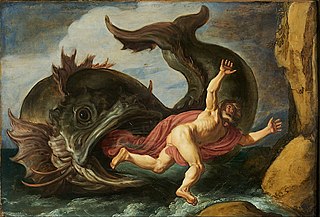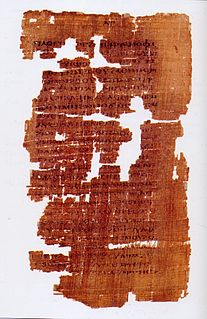Related Research Articles

The Bible is a collection of religious texts or scriptures sacred to Christians, Jews, Samaritans, Rastafari and others. It appears in the form of an anthology, a compilation of texts of a variety of forms that are all linked by the belief that they are collectively revelations of God. These texts include theologically-focused historical accounts, hymns, prayers, proverbs, parables, didactic letters, erotica, poetry, and prophecies. Believers also generally consider the Bible to be a product of divine inspiration.

The Book of Jonah is a book of the Nevi'im ("Prophets") in the Hebrew Bible. It tells of a Hebrew prophet named Jonah son of Amittai who is sent by God to prophesy the destruction of Nineveh but tries to escape the divine mission. The story has a long interpretive history and has become well known through popular children's stories. In Judaism, it is the Haftarah portion read during the afternoon of Yom Kippur to instill reflection on God's willingness to forgive those who repent; it remains a popular story among Christians. It is also retold in the Quran.

The deuterocanonical books are books and passages considered by the Catholic Church, the Eastern Orthodox Church, the Oriental Orthodox Churches and the Assyrian Church of the East to be canonical books of the Old Testament but which are considered non-canonical by Protestant denominations. They date from the period 300 BC–AD 100 approximately. While the New Testament never quotes from or ascribes canonical authority to these books, some say there is a correspondence of thought, while others see texts from these books being paraphrased, referred or alluded to many times in the New Testament, particularly in the Pauline epistles depending in large measure on what is counted as a reference.

The Epistle to the Laodiceans is a lost letter of Paul the Apostle, the original existence of which is inferred from an instruction to the congregation in Colossae to send their letter to the believing community in Laodicea, and likewise obtain a copy of the letter "from Laodicea".
And when this letter has been read to you, see that it is also read before the church at Laodicea, and that you yourselves read the letter which will be forwarded from there.

The King James Version (KJV), also known as the King James Bible (KJB), sometimes as the English version of 1611, or simply the Authorized Version (AV), is an English translation of the Christian Bible for the Church of England, commissioned in 1604 and completed as well as published in 1611 under the sponsorship of James I and VI. The books of the King James Version include the 39 books of the Old Testament, an intertestamental section containing 14 books of the Apocrypha, and the 27 books of the New Testament. Noted for its "majesty of style", the King James Version has been described as one of the most important books in English culture and a driving force in the shaping of the English-speaking world.

The Vulgate is a late-4th-century Latin translation of the Bible. It was to become the Catholic Church's officially promulgated Latin version of the Bible during the 16th century as the Sixtine Vulgate then as the Clementine Vulgate; the Vulgate is still presently used in the Latin Church.

In Christianity, the term Textus Receptus designates all editions of the Greek texts of the New Testament from the Novum Instrumentum omne established by Erasmus in 1516 to the 1633 Elzevier edition; the 1633 Elzevier edition is sometimes included into the Textus Receptus. It was the most commonly used text type for Protestant denominations.

The Bible has been translated into many languages from the biblical languages of Hebrew, Aramaic and Greek. As of September 2020 the full Bible has been translated into 704 languages, the New Testament has been translated into an additional 1,551 languages and Bible portions or stories into 1,160 other languages. Thus at least some portions of the Bible have been translated into 3,415 languages.

Epiousios (ἐπιούσιος) is a Greek adjective used in the Lord's Prayer verse "Τὸν ἄρτον ἡμῶν τὸν ἐπιούσιον δὸς ἡμῖν σήμερον" 'Give us today our epiousion bread'. Because the word is used nowhere else, its meaning is unclear. It is traditionally translated as "daily", but most modern scholars reject that interpretation.
The Dulcinians were a religious sect of the Late Middle Ages, originating within the Apostolic Brethren. The Dulcinians, or Dulcinites, and Apostolics were inspired by Franciscan ideals and influenced by the Joachimites, but were considered heretical by the Catholic Church. Their name derives from the movement's leader, Fra Dolcino of Novara, who was burned as a heretic on the orders of Pope Clement V.
Esdras is a Greco-Latin variation of the name of Hebrew Ezra the Scribe. The name is found in the titles of several books attributed to or associated with the scribe that are in or related to the Hebrew and Christian Bibles.

The Nova Vulgata, also called the Neo-Vulgate, the New Latin Vulgate or the New Vulgate, is the official Classical Latin translation of the original-language texts of the Bible from modern critical editions published by the Holy See for use in the contemporary Roman rite. It was completed in 1979, and was promulgated the same year by John Paul II in Scripturarum thesaurus. A second, revised, edition was promulgated in 1986, again by John Paul II. It is the official Latin text of the Catholic Church.

Matthew 3:2 is the second verse of the third chapter of the Gospel of Matthew in the New Testament. John the Baptist has just been introduced and this verse describes the message that he is preaching. Through John's message, Matthew introduces the "Kingdom of Heaven".

Matthew 25, the twenty-fifth chapter of the Gospel of Matthew, consists of three parables of Jesus:

The biblical apocrypha denotes the collection of apocryphal ancient books thought to have been written some time between 200 BC and 400 AD. Some Christian churches include some or all of the same texts within the body of their version of the Old Testament.
The Holy Bible: A Translation From the Latin Vulgate in the Light of the Hebrew and Greek Originals is a Catholic version of the Bible in three volumes translated by Monsignor Ronald Knox, the English theologian, priest and crime writer. It is more commonly known as the Knox Bible or Knox Version.

The Tyndale Bible generally refers to the body of biblical translations by William Tyndale. Tyndale's Bible is credited with being the first English translation to work directly from Hebrew and Greek texts. Furthermore, it was the first English biblical translation that was mass-produced as a result of new advances in the art of printing.
"They have pierced my hands and my feet", or "They pierced my hands and my feet" is a phrase that occurs in some English translations of Psalm 22:16. The text of the Hebrew Bible is obscure at this point, and Jewish and some Christian commentators translate this line differently, although there is no evidence of a deliberate mistranslation.
Metanoia, a transliteration of the Greek μετάνοια, means after-thought or beyond-thought, with meta meaning "after" or "beyond" and nous meaning "mind". It is commonly understood as "a transformative change of heart; especially: a spiritual conversion." The term suggests repudiation, change of mind, repentance, and atonement; but "conversion" and "reformation" may best approximate its connotation. In The King James Version of the Bible, its verbal cognate metanoeo/μετανοέω is translated as repent.
Penitenziagite is a rallying cry derived from the Latin "Poenitentiam agite," meaning the same. It has been also interpreted as a paraphrase of the Greek "πένητες διάγετε" attributed to Christ, meaning "live life as a pauper".
References
- 1 2 Campbell, George (1837). The Four Gospels, Translated from the Greek, with Preliminary Dissertations, and Notes Critical and Explanatory, Vol. I. New York: Gould and Newman. p. 358. ISBN 978-0-559-84612-0.
- ↑ Fra Dolcino Archived 2008-11-19 at the Wayback Machine Il Grido (in Italian)
- ↑ See the translations at "Sacred Texts: Matthew Chapter 3". and "Sacred Texts: Matthew Chapter 4" . Retrieved 2009-06-18.
- ↑ "Greek Bible: Mt. 3:2" . Retrieved 2009-06-18.
- ↑ Liddell, Henry George. "A Greek-English Lexicon:μετανοεω" . Retrieved 2010-09-07.
- ↑ McKim, Donald K. (1998). Historical Handbook of Major Biblical Interpreters. Downers Grove, IL: InterVarsity Press. p. 187. ISBN 978-0-8308-1452-7.
- ↑ "Sacred Texts: Mark Chapter 1" . Retrieved 2009-06-18.